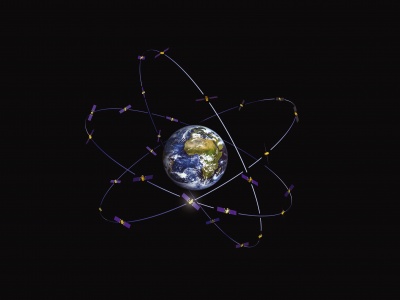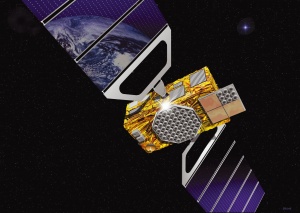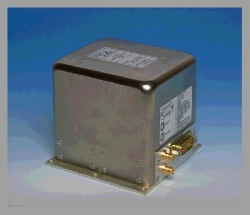If you wish to contribute or participate in the discussions about articles you are invited to contact the Editor
Galileo Space Segment
| GALILEO | |
|---|---|
| Title | Galileo Space Segment |
| Edited by | GMV |
| Level | Basic |
| Year of Publication | 2011 |
The GALILEO Space segment is composed of a constellation of 30 Galileo satellites, each of which will broadcast navigation timing signals together with navigation data providing the clock and ephemeris correction data which are essential for navigation.
The GALILEO space segment will comprise 30 satellites in a constellation with three orbital planes at 56° nominal inclination.[1] Each plane will contain 8 operational satellites, equally spaced, 45° apart, plus two spare satellite to replace any of the operational satellites in case of failures. The orbit altitude of 23 222 km results in a constellation configuration that repeats itself after ten days during which each satellite has completed seventeen revolutions.
Constellation features
The altitude of the satellites has been chosen to avoid gravitational resonances so that, after initial orbit optimisation, station-keeping manoeuvres will not be needed during the lifetime of a satellite. The altitude chosen also ensures a high visibility of the satellites.
The position constraints for individual satellites are set by the need to maintain a uniform constellation, for which it is specified that each satellite should be within +/- 2° of its nominal position relative to the adjacent satellites in the same orbit plane and should be within 2° of the orbit plane.
The in-plane accuracy is equivalent to a relative tolerance of over 1000 km but requires very careful adjustment of the satellite velocity to ensure that the orbit period of all the satellites is kept precisely the same. The across-track tolerance allows the inclination and Right Ascension of the Ascending Node (RAAN) of each satellite to be biased at launch so that natural drifts remain within the tolerance without the need for orbit plane changes requiring major expense of fuel.
The spare satellite in each orbit plane ensures that in case of failure the constellation can be repaired quickly by moving the spare to replace the failed satellite. This could be done in a matter of days, rather than waiting for a new launch to be arranged which could take many months. The satellites are designed to be compatible with a range of launchers providing multiple and dual launch capabilities.
There are good reasons for choosing such a structure for the Galileo constellation. With 30 satellites at such an altitude, there is a very high probability (more than 90%) that anyone anywhere in the world will always be in sight of at least four satellites and hence will be able to determine their position from the ranging signals broadcast by the satellites. The inclination of the orbits was chosen to ensure good coverage of polar latitudes, which are poorly served by the US GPS system.
From most locations, six to eight satellites will always be visible, allowing positions to be determined very accurately – to within a few centimeters. Even in high rise cities, there will be a good chance that a road user will have sufficient satellites overhead for taking a position, especially as the Galileo system will be interoperable with the US system of 24 GPS satellites.
Galileo satellites
The Galileo constellation is composed of a total of 30 Medium Earth Orbit (MEO) satellites, of which 6 are spares. Each satellite will broadcast precise time signals, ephemeris and other data. The Galileo satellite constellation has been optimised to the following nominal constellation specifications:[2]
- circular orbits (satellite altitude of 23 222 km)
- orbital inclination of 56°
- three equally spaced orbital planes
- eight operational satellites, equally spaced in each plane
- two spare satellite (also transmitting) in each plane
The Galileo satellite is a 700 kg/1600 W class satellite.
The image shows an artist's impression of a Galileo spacecraft in orbit with solar arrays deployed. The spacecraft rotates about its Earth-pointing axis so that the flat surface of the solar arrays always faces the Sun to collect maximum solar energy. The antennas, shown on the underside of the body in the picture, always point towards the Earth. The spacecraft body will measure 2.7 m x 1.1 m x 1.2 m and the deployed solar arrays span 13 m.
Galileo Satellite components
The L-band antenna transmits the navigation signals in the 1200-1600 MHz frequency range.
The SAR (Search and Rescue) antenna picks up distress signals from beacons on Earth and transmits them to a ground station for forwarding to local rescue services.
The C-band antenna receives signals containing mission data from Galileo Uplink Stations. This includes data to synchronise the on-board clocks with a ground-based reference clock and integrity data which contains information about how well each satellite is functioning. The integrity information is incorporated into the navigation signal for transmission to users.
Two S-band antennas are part of the telemetry, tracking and command subsystem. They transmit housekeeping data about the payload and spacecraft to ground control and, in turn, receive commands to control the spacecraft and operate the payload. The S-band antennas also receive, process and transmit ranging signals that measure the satellite's altitude to within a few metres.
The infrared Earth sensors and the Sun sensors both help to keep the spacecraft pointing at the Earth. The infrared Earth sensors do this by detecting the contrast between the cold of deep space and the heat of the Earth's atmosphere. The Sun sensors are visible light detectors which measure angles between their mounting base and incident sunlight.
The laser retro-reflector allows the measurement of the satellite's altitude to within a few centimetres by reflecting a laser beam transmitted by a ground station. The laser retro-reflector is used only about once a year, as altitude measurements via S-band antenna ranging signals are otherwise accurate enough.
The space radiators are heat exchangers that radiate waste heat, produced by the units inside the spacecraft, to deep space and thus help to keep the units within their operational temperature range.
Interior: payload
A passive hydrogen maser clock is the master clock on board the spacecraft. It is an atomic clock which uses the ultra stable 1.4 GHz transition in a hydrogen atom to measure time to within 0.45 ns over 12 hours.
A rubidium clock will be used should the maser clock fail. It is accurate to within 1.8 ns over 12 hours.
The spacecraft has four clocks, two of each type. At any time, only one of each type is operating. Under normal conditions, the operating maser clock produces the reference frequency from which the navigation signal is generated. Should the maser clock fail, however, the operating rubidium clock will take over instantaneously and the two reserve clocks will start up. If the problem with the failed maser clock is unique to that clock, the second maser clock will take over from the rubidium clock after a few days when it is fully operational. The rubidium clock will then go on stand-by or reserve again. In this way, by having four clocks, the Galileo spacecraft is guaranteed to generate a navigation signal at all times.
The clock monitoring and control unit provides the interface between the four clocks and the navigation signal generator unit (NSU). It passes the signal from the active master clock to the NSU and also ensures that the frequencies produced by the master clock and the active spare are in phase, so that the spare can take over instantly should the master clock fail.
The navigation signal generator, frequency generator and up-conversion units are in charge of generating the navigation signals using input from the clock monitoring unit and the up-linked navigation and integrity data from the C-band antenna. The navigation signals are converted to L-band for broadcast to users.
The remote terminal unit is the interface between all the payload units and the on-board computer.
Interior: service module
SADM is the drive mechanism that connects the solar arrays to the spacecraft and rotates them slowly so that the surface of the arrays can remain perpendicular to the Sun's rays at all times.
The gyroscopes measure the rotation of the spacecraft.
The reaction wheels control the rotation of the spacecraft. When they rotate, so does the spacecraft. It rotates twice per orbit to allow the solar arrays to remain parallel to the Sun's rays.
The magneto bar modifies the speed of rotation of the reaction wheels by introducing a torque (turning force) in the opposite direction.
The power conditioning and distribution unit regulates and controls power from the solar arrays and batteries and distributes it to all the spacecraft's subsystems and payload.
The environmental monitoring unit on-board takes radiation measurements.
The on-board computer controls all aspects of spacecraft and payload functioning.
Launching and phases
Up to date information on the Galileo program, namely launching and phases can be found here.
Notes
References
- ^ Galileo Early Services, European GNSS Agency (GSA)
- ^ Galileo Mission High Level Definition, v3, September 2002.



